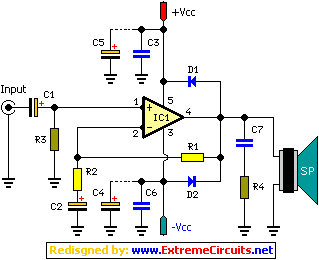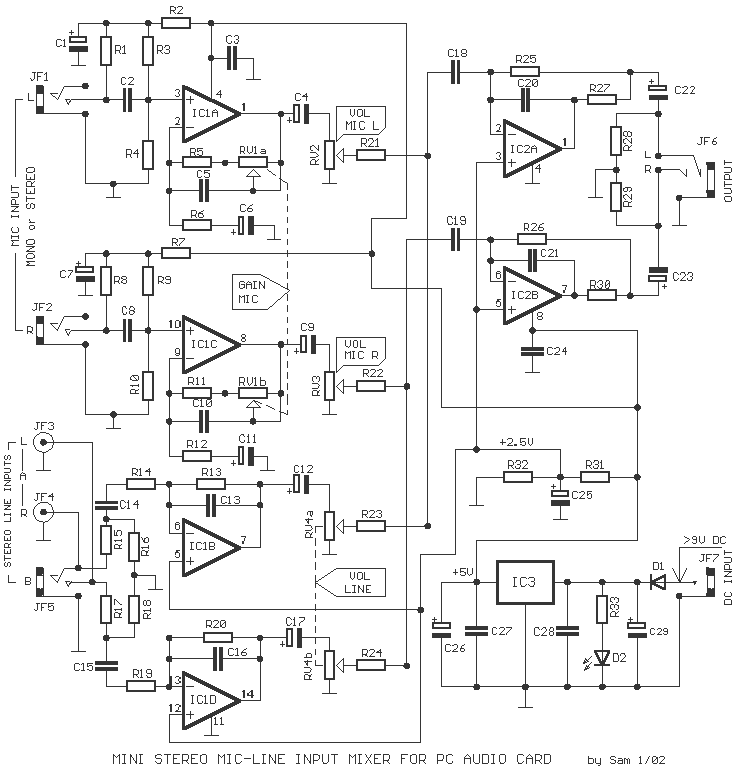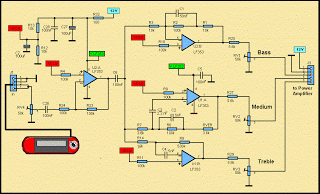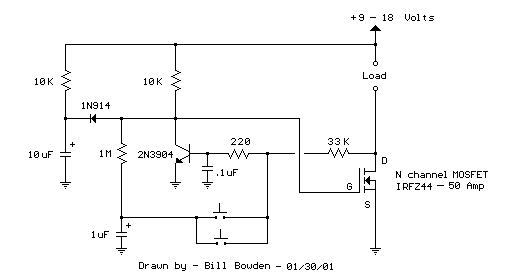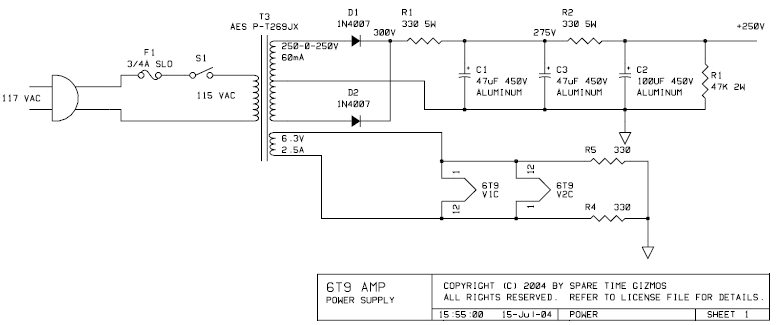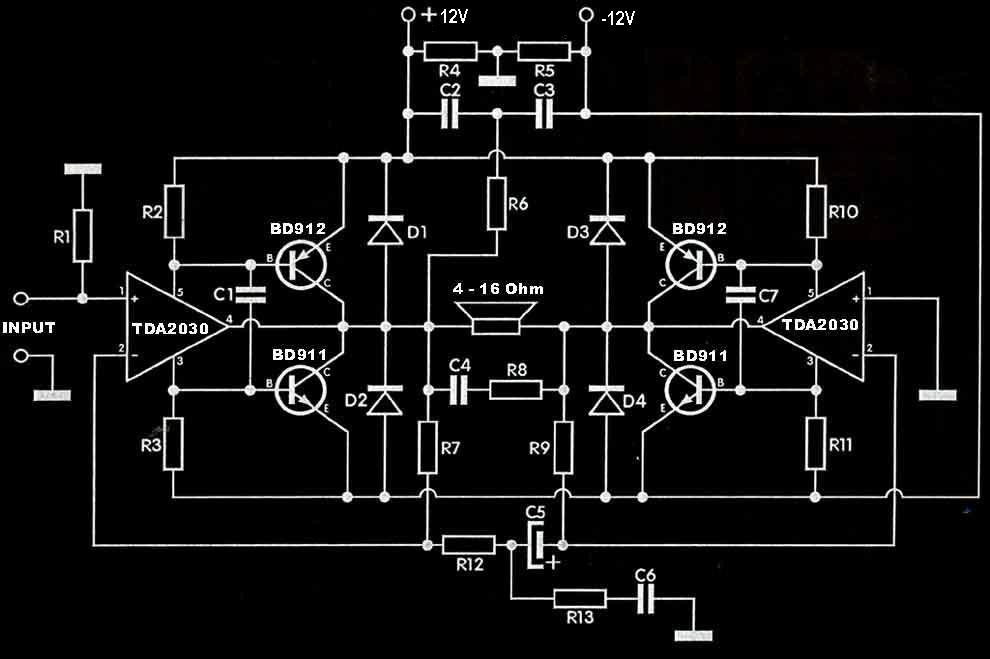
25 Watt MosFet Audio Amplifier
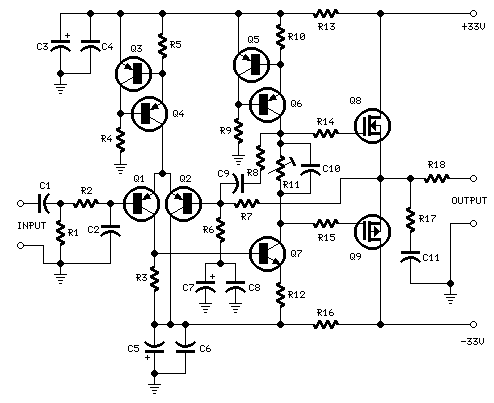
Can be directly connected to CD players, tuners and tape recorders. Simply add a 10K Log potentiometer (dual gang for stereo) and a switch to cope with the various sources you need. A correct grounding is very important to eliminate hum and ground loops. Connect in the same point the ground sides of R1, R4, R9, C3 to C8. Connect C11 at output ground. Then connect separately the input and output grounds at power supply ground. More: Adjust R11 to set quiescent current at 100mA (best measured with an Avo-meter in series with Q8 Drain) with no input signal. Adjust R11 to set quiescent current at 100mA (best measured with an Avo-meter in series with Q8 Drain) with no input signal.
The described circuit is designed for audio applications, enabling direct connections to various audio sources such as CD players, tuners, and tape recorders. The inclusion of a 10K logarithmic potentiometer, configured as a dual gang for stereo applications, allows for volume control and source selection, enhancing the user experience by accommodating multiple audio inputs.
Grounding is a critical aspect of this circuit to mitigate noise issues such as hum and ground loops. It is essential that the ground connections for resistors R1, R4, R9, and capacitors C3 to C8 are tied together at a single point, ensuring a common reference for the circuit elements. Additionally, capacitor C11 should be connected to the output ground to maintain signal integrity. It is also important to separate the input and output grounds from the power supply ground to further reduce the risk of noise interference.
For optimal performance, resistor R11 is utilized to set the quiescent current of the circuit at 100mA. This adjustment is crucial for maintaining the linear operation of the circuit and is best performed with an Avo-meter, which should be placed in series with the drain of transistor Q8. This measurement should be taken with no input signal applied to ensure accurate setting of the quiescent current. Proper calibration of R11 is essential for achieving the desired audio performance and stability in the circuit.Can be directly connected to CD players, tuners and tape recorders. Simply add a 10K Log potentiometer (dual gang for stereo) and a switch to cope with the various sources you need. A correct grounding is very important to eliminate hum and ground loops. Connect in the same point the ground sides of R1, R4, R9, C3 to C8. Connect C11 at output ground. Then connect separately the input and output grounds at power supply ground. Adjust R11 to set quiescent current at 100mA (best measured with an Avo-meter in series with Q8 Drain) with no input signal. Adjust R11 to set quiescent current at 100mA (best measured with an Avo-meter in series with Q8 Drain) with no input signal.
🔗 External reference
The described circuit is designed for audio applications, enabling direct connections to various audio sources such as CD players, tuners, and tape recorders. The inclusion of a 10K logarithmic potentiometer, configured as a dual gang for stereo applications, allows for volume control and source selection, enhancing the user experience by accommodating multiple audio inputs.
Grounding is a critical aspect of this circuit to mitigate noise issues such as hum and ground loops. It is essential that the ground connections for resistors R1, R4, R9, and capacitors C3 to C8 are tied together at a single point, ensuring a common reference for the circuit elements. Additionally, capacitor C11 should be connected to the output ground to maintain signal integrity. It is also important to separate the input and output grounds from the power supply ground to further reduce the risk of noise interference.
For optimal performance, resistor R11 is utilized to set the quiescent current of the circuit at 100mA. This adjustment is crucial for maintaining the linear operation of the circuit and is best performed with an Avo-meter, which should be placed in series with the drain of transistor Q8. This measurement should be taken with no input signal applied to ensure accurate setting of the quiescent current. Proper calibration of R11 is essential for achieving the desired audio performance and stability in the circuit.Can be directly connected to CD players, tuners and tape recorders. Simply add a 10K Log potentiometer (dual gang for stereo) and a switch to cope with the various sources you need. A correct grounding is very important to eliminate hum and ground loops. Connect in the same point the ground sides of R1, R4, R9, C3 to C8. Connect C11 at output ground. Then connect separately the input and output grounds at power supply ground. Adjust R11 to set quiescent current at 100mA (best measured with an Avo-meter in series with Q8 Drain) with no input signal. Adjust R11 to set quiescent current at 100mA (best measured with an Avo-meter in series with Q8 Drain) with no input signal.
🔗 External reference
